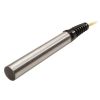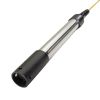Global Water WQ-COND Conductivity Sensor
Features
- Fully encapsulated electronics
- 4-20 mA output
- Select from multiple conductivity ranges
- Free ground shipping
- Expedited repair and warranty service
- Lifetime technical support
- More
The Global Water WQ-COND Conductivity Sensors are suitable for measuring conductivity in a wide variety of applications including laboratories, streams, rivers, and groundwater. The conductivity sensor's small size and rugged housing make it useful for handheld measurements or permanent installation.
The conductivity sensors use a 4-electrode measuring technique that provides accurate readings over a wide range of conductivities and temperatures. Because the conductivity of ionic solutions increases with increasing temperature, a temperature sensor is also incorporated and is used to provide automatic temperature compensation of 2%/°C normalized to 25°C. An in-line interface module converts the digital conductivity sensor and temperature data into two separate 4-20mA signals for monitoring with data loggers and PLC devices.
The standard conductivity sensors come with three feet (one meter) of cable between the conductivity sensor and interface module, and 25 feet of marine-grade cable for connecting to recording devices. Available conductivity ranges are 200-2000µS/cm and 2-20mS/cm. The conductivity sensor's temperature output has a measurement range of -5°C to +70°C.
| Specifications | |
|---|---|
| Conductivity Ranges | 200 to 2000 µS/cm 2 to 20 mS/cm |
| Temperature Range |
23 to 158°F (-5 to 70°C) |
| Conductivity Accuracy | +0.5% of reading |
| Temperature Accuracy |
+0.4ºF (+0.2ºC) |
| Conductivity Resolution | 1 µS/cm 0.01 mS/cm |
|
Temperature Resolution |
0.02°F (0.01°C) |
| Output |
Dual 4-20 mA |
| Temperature Response | 99% in <20 seconds |
| Maximum Pressure |
35 psi (82 ft (25m)) |
| Immersion Depth | 1.4 inches (36 mm) |
| Operating Voltage |
10-36 VDC |
| Current Draw |
20 mA plus the sum of both sensor outputs |
| Warm-Up Time | 3 seconds minimum |
| Operating Temperature |
23 to +158°F (-5 to +70°C) |
| Storage Temperature | -4 to +212°F (-20 to +100°C) |
| Dimensions |
8 inch L x 0.86 inch Diameter (202 mm L x 22 cm Dia.) |
| Weight |
8 oz (227 g) plus cable |
In The News
Wildfire Prevention in the Sierra Nevada Region with the Yuba Watershed Institute
Though recent wildfires have sparked new conversations about wildfire management and response, groups like the Yuba Watershed Institute have been monitoring the forests and water resources of the Sierra Nevada region for decades, managing approximately 5,000 acres of land with the Bureau of Land Management (BLM) and about 7,000 acres in private land partnerships. The goal of the Institute is to work with local communities and land agencies to improve watershed and forestry management through informed practices and public outreach. The goals of the Yuba Watershed Institute are three-fold: Improve the ability of fire suppression agencies like the California Department of Forestry and Fire Protection ( CAL FIRE ) and the US Forest Service.
Read MoreWave Sensors Integration with NexSens Buoys: A Cutting-Edge Solution for Wave Measurment
Real-time wave data supports accurate weather prediction, safe and efficient maritime operations, and provides valuable safety and operating condition information for recreation and commercial fishing. Understanding wave dynamics also helps with the design of protective coastal structures like seawalls, breakwaters, and jetties. It also supports better prediction of their impact on sediment transport and coastal geomorphology. Wave data is a key factor in qualifying and designing offshore wind farms and harnessing kinetic energy for electrical generation. It helps with the understanding of ocean-atmosphere interactions and contributes to studies of sea-level rise and climate change impacts.
Read MoreSpring 2025 Environmental Monitor Available Now
In the Spring 2025 edition of the Environmental Monitor, we highlight partnerships across the world and the importance of collaboration between government agencies, universities, environmental groups, local communities, and other stakeholders. From great white shark research in Cape Cod to monitoring fisheries in Lake Erie, this latest edition underscores partnerships that connect stakeholders in a watershed through environmental data. With an emphasis on data sharing, a combination of real-time and discrete sampling keeps the public and partners informed of environmental conditions. Our writers also sought out science professionals dedicated to working with peers within and outside of the environmental sector.
Read More









